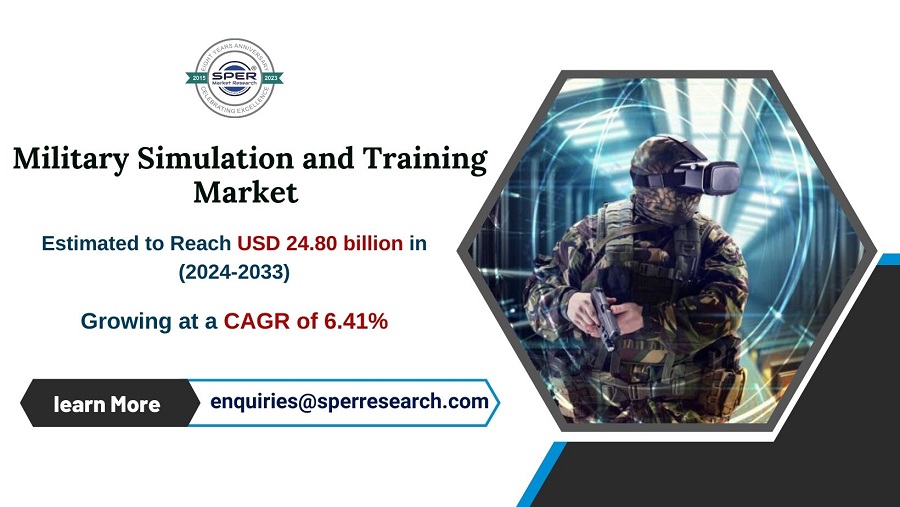Military Simulation and Training Market Size and Growth, Revenue, Rising Trends, Key Players, Challenges, Future Opportunities, and Forecast Till 2033: SPER Market Research

The performance of weapon systems, the fighting environment, and actual combat are all replicated in military simulation training through the widespread use of contemporary simulation technology built on computers, virtual reality, artificial intelligence, and distributed simulation. By using highly realistic models of their adversary, combat mission, and combat procedure, the department and trainees can experience the environment as though it were an actual installation and as though there was an actual conflict. This could raise their degree of training. By building a realistic simulated training environment based on contemporary science and technology, simulated training can more objectively and accurately reflect the training level of the training unit and has greater training pertinence.
According to SPER Market Research, ‘Military Simulation and Training Market Size- By Type, By Application, By Platform, By Environment- Regional Outlook, Competitive Strategies and Segment Forecast to 2033’ states that the Military Simulation and Training Market is estimated to reach USD 24.80 billion by 2033 with a CAGR of 6.41%.
Growing geopolitical tensions and changing international security concerns make military readiness imperative. To guarantee that staff members are prepared to manage a variety of complex and dynamic operational scenarios, defence ministries and military organizations place a high priority on investments in training programs and simulation capabilities. The necessity for interoperability among the various military branches is highlighted by the move toward network-centric warfare and combined military operations. Through cooperative training exercises made possible by military simulations, personnel can develop the cooperative techniques and tactics necessary for successful mission execution in contemporary conflict. The growing practice of contracting out training services to independent contractors and third-party providers supports market expansion.
For both buyers and sellers, hefty upfront investment expenditures and continuous maintenance costs provide substantial financial obstacles. Some defence organizations and technology corporations find it difficult to acquire modern simulation technologies due to the significant costs needed for their development and upkeep. It can be difficult to ensure that simulations are realistic and accurate, especially when it comes to simulating complex battlefield environments and human behaviour. Integration problems also occur when trying to link disparate simulation systems among various armed forces and branches, hindering interoperability and cooperative training initiatives. It is consistently difficult to strike a balance between the requirement for high-fidelity training and accessibility and usability since excessively intricate simulations can overwhelm users and obstruct learning objectives. Finally, worries about cybersecurity and legal compliance with relation to data privacy and protection add yet another level of complexity.
Request For Free Sample Report @ https://www.sperresearch.com/report-store/military-simulation-and-training-market.aspx?sample=1
Traditional in-person military training was disrupted by the COVID-19 epidemic, which increased the need for virtual and remote alternatives. This change hastened the defence industry’s adoption of digital technologies and raised demand for lifelike simulation systems that facilitate remote training. Some regions’ defence budgets were impacted by economic uncertainties resulting from the epidemic, which led to the postponement or termination of specific training programs and procurement efforts. But the crisis also made clear how crucial flexible training approaches are to preserving military readiness. COVID-19 presented obstacles for the military simulation and training industry, but it also created long-term growth prospects for businesses who provide cutting-edge simulation and training solutions.
The market in North America is anticipated to grow at the fastest CAGR. In order to minimize time, effort, and equipment wear and tear, the region offers trainees cutting-edge technology and platforms for military simulation and training. Lockheed Martin, Northrop Gumman, L3Harris Technologies, Raytheon Technologies, Rheinmetall AG, BAE Systems, Others are the key players of the market.
Military Simulation and Training Market Segmentation:
By Type:
- Live
- Virtual
- Constructive
By Application:
- Army
- Aviation
- Naval
By Platform:
- Land
- Maritime
- Airborne
By Environment:
- Synthetic
- Gaming
By Region:
- North America
- Asia-Pacific
- Latin America
- Middle East & Africa and Europe
For More Information, refer to below link:-
Military Simulation and Training Market Outlook
Related Reports:
Commercial Aircraft Aftermarket Parts Market Outlook 2033
North America Aviation Fuel Market Forecast 2033
Contact Us:
Sara Lopes, Business Consultant – USA
+1-347-460-2899





